

4 Signs You Might Be Confusing, Not Intriguing, in Your Opening Scene. By Janice Hardy, @Janice_Hardy The opening scene of a novel walks a fine line between piquing curiosity and confusing the reader.
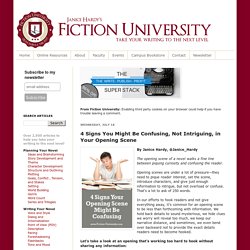
Opening scenes are under a lot of pressure—they need to pique reader interest, set the scene, introduce characters, and give just enough information to intrigue, but not overload or confuse. That’s a lot to ask of 250 words. In our efforts to hook readers and not give everything away, it’s common for an opening scene to be less than forthcoming with information. We hold back details to sound mysterious, we hide clues we worry will reveal too much, we keep our narrative distance, and sometimes, we even bend over backward not to provide the exact details readers need to become hooked. Let’s take a look at an opening that’s working too hard to hook without sharing any information: He waited in the shadows, watching.
As a generic opening scene, this isn’t that bad on first glance. Can you tell what genre it is? 1. 2. 3. Om Tare Tuttare - Ani Choying Dolma. Literatura. Writing Craft. Postmodernism in poetry. To repeat a previous simplification: whereas Classicism, Realism and Romanticism all deal with the outside world, contemporary literature, by contrast, is commonly a retreat into the writer's consciousness — to make autonomous creations that incorporate diverse aspects of modern life (Modernism), or free-wheeling creations constructed of a language that largely points to itself (Postmodernism).
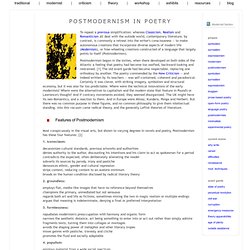
Postmodernism began in the sixties, when there developed on both sides of the Atlantic a feeling that poetry had become too ossified, backward-looking and restrained. {1} The old avant garde had become respectable, replacing one orthodoxy by another. The poetry commended by the New Criticism — and indeed written by its teachers — was self-contained, coherent and paradoxical.
Certainly it was clever, with striking imagery, symbolism and structural economy, but it was also far too predictable. Where were the technical innovations of the early modernists? Features of Postmodernism. Bullet Journal Instructions – Bullet Journal.
Writing Graphic Organizers. Deep Underground Poetry : Welcome Siharyvani - Deep Underground Poetry Community. Any questions?
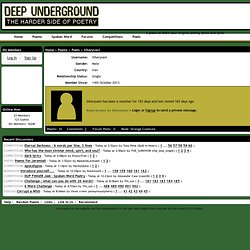
Help Advanced Search a place to share your original poetry, prose and lyrics Recent Discussions COMPETITIONS Eternal Darkness - 6 words per line, 3 lines - Today at 2:52pm by Tony Pena (Quill-in-Heart) ( 1 ... 56 57 58 59 60 ) COMPETITIONS Who has the most sinister mind, spirt, and soul? Help |Random Poems |Links |Link to Us |Recommend. Monomyth. Joseph Campbell's monomyth, or the hero's journey, is a basic pattern that its proponents argue is found in many narratives from around the world.
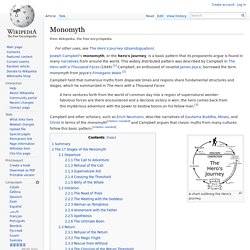
This widely distributed pattern was described by Campbell in The Hero with a Thousand Faces (1949).[1] Campbell, an enthusiast of novelist James Joyce, borrowed the term monomyth from Joyce's Finnegans Wake.[2] Campbell held that numerous myths from disparate times and regions share fundamental structures and stages, which he summarized in The Hero with a Thousand Faces: A hero ventures forth from the world of common day into a region of supernatural wonder: fabulous forces are there encountered and a decisive victory is won: the hero comes back from this mysterious adventure with the power to bestow boons on his fellow man.[3] A chart outlining the Hero's Journey. Summary[edit] In a monomyth, the hero begins in the ordinary world, and receives a call to enter an unknown world of strange powers and events. The 17 Stages of the Monomyth[edit] Welcome to Teaching That Makes Sense! Write. General Fiction.
Getting Around...
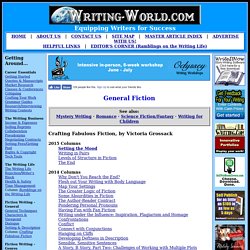
Career Essentials Getting Started Queries & Manuscripts Market Research Classes & Conferences Critiquing Crafting Your Work Grammar Guides Research/Interviewing Writing Contests The Writing Business Income & Expenses Selling Reprints Collaboration Pseudonyms Negotiating Contracts Setting Fees/Getting Paid Rights & Copyright Tech Tools The Writing Life The Writing Life Rejection/Writer's Block Health & Safety Time ManagementColumn: Ramblings on the Writing Life Fiction Writing - General General Techniques Characters & Viewpoint Dialogue Setting & DescriptionColumn: Crafting Fabulous Fiction. 8 ½ Character Archetypes You Should Be Writing. Here’s the thing about character archetypes: everybody’s got his own take.
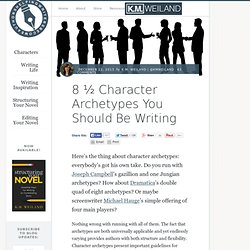
Do you run with Joseph Campbell’s gazillion and one Jungian archetypes? How about Dramatica’s double quad of eight archetypes? Or maybe screenwriter Michael Hauge’s simple offering of four main players? Nothing wrong with running with all of them. The fact that archetypes are both universally applicable and yet endlessly varying provides authors with both structure and flexibility. Today, we’re going to explore my take, which is primarily based on Dramatica’s eight characters. 1. This one doesn’t need much explanation. The main actor.The person most greatly affected by the Antagonist.The person whose reactions and actions drive the majority of the plot.The person with whom the readers will identify most strongly.The person whose inner journey, as influenced by the outer conflict, will be the most obvious manifestation of your story’s theme. Examples 2. This one’s also pretty clear. 3. 4.